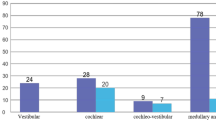Abstract
The level of success of neurovascular decompression in ponto-cerebellar angle for hemifacial spasm and trigeminal neuralgia has already established the reality of the pathology to explain such symptoms. However, cochlear nerve compression syndrome by vascular loop is still a controversial topic. We have performed a retrospective cases review with long-term follow-up (5–7 years) concerning the results of microvascular decompression surgery of the cochlear nerve via an endoscopy assisted retrosigmoid approach on 15 patients suffering from unilateral incapacitating tinnitus with abnormal auditory brainstem response and an offending vessel on magnetic resonance imaging. During the surgery, a vascular compression was found on every patient. In a long-term follow-up, 53.3% (8 cases) of our tinnitus cases improved and 20% (3 cases) of them were completely cured. The ABR returned to normal in all patients who had good clinical results (diminished or disappeared tinnitus). When a vertebral artery loop (5 cases) was concerned we obtained 80% of good clinical results. No one showed amelioration or sudden aggravation of their hearing. Three cases required surgical correction of cerebrospinal fluid leak and one case developed spontaneously regressive swallowing problems. Such microvascular decompression surgery of the cochlear nerve appears to be successful in treating incapaciting tinnitus in particular when a vertebral artery loop is observed. Therefore, in such a case, one might recommend neurovascular decompression surgery, keeping in mind that the complications of this surgery should be minimized by a careful closure of the retrosigmoid approach. In order to ensure a better selection of patient more accurate cochlear nerve monitoring and functional MRI should be a promising assessment.



Similar content being viewed by others
References
El-Garem HF, Badr-El-Dine M, Talaat AM, Magnan J (2002) Endoscopy as a tool in minimally invasive trigeminal neuralgia surgery. Otol Neurotol 23:132–135
Badr-El-Dine M, El-Garem HF, Talaat AM, Magnan J (2002) Endoscopically assisted minimally invasive microvascular decompression of hemifacial spasm. Otol Neurotol 23:122–128
Adams CBT (1989) Microvascular compression: an alternative view and hyposthesis. J Neurosurg 57:1–12
Moller MB, Moller AR, Jannetta PJ et al (1993) Vascular decompression surgery for severe tinnitus: selection criteria and results. Laryngoscope 103:421–427
Brookes GB (1996) Vascular-decompression surgery for severe tinnitus. Am J Otol 17:569–576
Vasama JPI, Moller MB, Moller AR (1998) Microvascular decompression of the cochlear nerve in patients with severe tinnitus. Preoperative findings and operative outcome in 22 patients. Neurol Res 20:242–248
Okamura T, Kurokawa Y, Ikeda N et al (2000) Microvascular decompression for cochlear symptoms. J Neurosurg 93:421–426
Ryu H, Yamamoto S, Sugiyama K (1998) Neurovascular compression syndrome of the eight cranial nerve. What are the most reliable diagnostic signs? Acta Neurochir (Wien) 140:1279–1286
Makins AE, Nikolopoulos TP, Ludman C et al (1998) Is there a correlation between vascular loops and unilateral auditory symptoms? Laryngoscope 108:1739–1742
Weissman JL, Hirsch BE (2000) Imaging of tinnitus: a review. Radiology 216:342–349
Lang J (1981) Facial and vestibulocochlear nerve. Topographic anatomy and variations. In: Samii M, Jannetta PJ (eds) The cranial nerves. Springer, Heidelberg, pp 363–377
Wackym PA, King WA, Meyer GA et al (2002) Endoscopy in neuro-otologic surgery. Otolaryngol Clin North Am 35:297–323
Moller AR, Moller MB, Jannetta PJ et al (1992) Compound action potentials recorded from the exposed eight nerve in patients with intractable tinnitus. Laryngoscope 102:187–197
Legatt AD (2002) Mechanisms of intraoperative brainstem auditory evoked potential changes. J Clin Neurophysiol 19:396–408
MelcherJR, Sigalovsky IS, Guinan JJ et al (2000) Lateralized tinnitus studied with functional magnetic resonance imaging: Abnormal inferior colliculus activation. J Neurophysiol 83:1058–1072
Author information
Authors and Affiliations
Corresponding author
Rights and permissions
About this article
Cite this article
Guevara, N., Deveze, A., Buza, V. et al. Microvascular decompression of cochlear nerve for tinnitus incapacity: pre-surgical data, surgical analyses and long-term follow-up of 15 patients. Eur Arch Otorhinolaryngol 265, 397–401 (2008). https://doi.org/10.1007/s00405-007-0471-1
Received:
Accepted:
Published:
Issue Date:
DOI: https://doi.org/10.1007/s00405-007-0471-1




